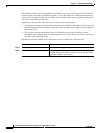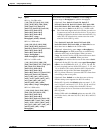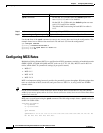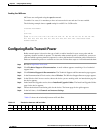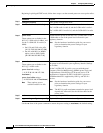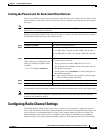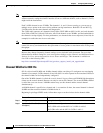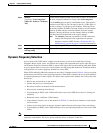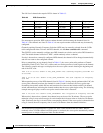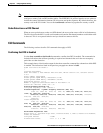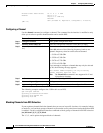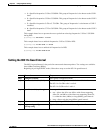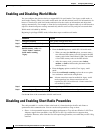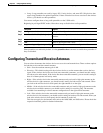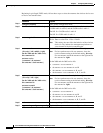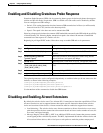
6-18
Cisco IOS Software Configuration Guide for Cisco Aironet Access Points
OL-30644-01
Chapter 6 Configuring Radio Settings
Configuring Radio Channel Settings
The full list of channels that require DFS is shown in Table 6-3.
For autonomous operation, DFS requires random channel selection among the channels listed in
Table 6-3. The channels not listed in Table 6-3 do not require random selection and may be manually
configured.
Channels requiring Dynamic Frequency Selection (DFS) may be manually selected from the 5 GHz
radio configuration menu. To know the DFS channels, use the show controllers d1 command.
The GUI/CLI used to manually configure non-DFS channels can also be used to select DFS channels as
well. The default channel selection is "DFS", which randomly selects a channel.
If radar is detected on a manually configured DFS channel, the channel will be changed automatically
and will not return to the configured channel.
Prior to transmitting on any channels listed in Table 6-3, the access point radio performs a Channel
Availability Check (CAC). The CAC is a 60 second scan for the presence of radar signals on the channel.
The following sample messages are displayed on the access point console showing the beginning and
end of the CAC scan:
*Mar 6 07:37:30.423: %DOT11-6-DFS_SCAN_START: DFS: Scanning frequency 5500 MHz for
60 seconds
*Mar 6 07:37:30.385: %DOT11-6-DFS_SCAN_COMPLETE: DFS scan complete on frequency
5500 MHz
When operating on any of the DFS channels listed in Table 6-3, having already performed the CAC, the
access point constantly monitors the channel for radar. If radar is detected, the access point stops
forwarding data packets within 200 ms and broadcasts five beacons that include an 802.11h channel
switch announcement, indicating the channel number that the access point begins using. The following
example message displays on the access point console when radar is detected:
*Mar 6 12:35:09.750: %DOT11-6-DFS_TRIGGERED: DFS: triggered on frequency 5500 MHz
When radar is detected on a channel, that channel may not be used for 30 minutes. The access point
maintains a flag in non-volatile storage for each channel that it detects radar on in the last 30 minutes.
After 30 minutes, the flag is cleared for the corresponding channel. If the access point is rebooted before
a flag is cleared, the non-occupancy time is reset to 30 minutes when the channel initializes.
Note The maximum legal transmit power is greater for some 5-GHz channels than for others. When it
randomly selects a 5-GHz channel on which power is restricted, the access point automatically reduces
transmit power to comply with power limits for that channel.
Ta b l e 6 - 3 DF S Channel List
Channel Frequency Channel Frequency Channel Frequency
52 5260 MHz 104 5500 MHz 124 5620 MHz
56 5280 MHz 108 5520 MHz 128 5640 MHz
60 5300 MHz 112 5560 MHz 132 5660 MHz
64 5320 MHz 116 5580 MHz 136 5680 MHz
100 5500 MHz 120 5600 MHz 140 5700 MHz



